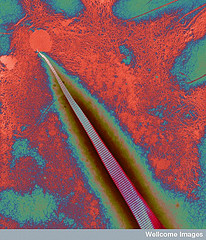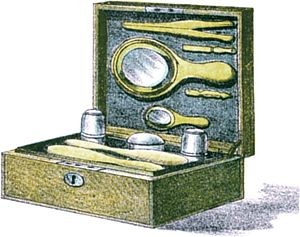The beauty and the anti-ageing industry is focused on finding ways to augment the fibrillar proteins collagen and elastin embedded in an extracellular matrix in the dermal layer of the skin. A pentapeptide KTTKS, within the carboxy terminal propeptide of type I collagen is extensively used as an anti-ageing cosmetic ingredient. The proposed mechanism of action is tricking the body into believing that there is excessive collagen degradation so that collagen biosynthetic pathway is stimulated. I have blogged about the potential limitations in Skin Deep .
 |
| B0005968 Collagen fibril forming in vitro (Photo credit: wellcome images) |
Yet another peptide called tetrapeptide – 21 is claimed to be superior to KTTKS in anti-ageing properties. They claim to have discovered this by using bioinformatics methodology.
Let me quote from a product brochure:
We used bioinformatic methods to identify highly repetitive amino acid motifs in several human ECM proteins to identify sequences with inherent anti-aging activities. Using the amino acid sequences of collagen I, II, III, IV, V, elastin, and proelastin, tetra-peptide sequences were identified by their frequency of occurrence.
 |
| Beauty box1886 (Photo credit: Wikipedia) |
The methodology has never been published. Their patent application states that they found GXXG and PXXP as the common motif among all collagens and elastin. They tried various combinations and found GEKG as the most biologically active one. At the sequence level all collagens are quite similar. It is also well known that the most common motifs in all types of collagen is GPX. So finding GXXG as the commonest tetrapeptide motif is hardly surprising.
So dear biochemicians:
1. Where does the MMPs cleave collagen?
2. How many amino acid residues are there in collagen degradation fragments?
3. Do you think GXXG can mimick collagen fragment?
and dear bioinformaticians:
1. If we consider Collagen I & III into consideration (more relevant for skin) which are the commonest penta and hexa peptide motifs. Do they converge?
 |
| Susan Anton (Photo credit: Wikipedia) |
2. How does adding an H to the carboxy terminal of such a penta/hexapeptide affect the polarity? Will it increase the skin penetration as described here? http://www.ncbi.nlm.nih.gov/pubmed/22452335
and finally dear cell biologists:
1. Do all collagen degradation fragments stimulate UVB induced hyaluronic acid degradation as described here: http://www.ncbi.nlm.nih.gov/pubmed/21454612
I have added a wiki page for this to summarise the findings. Feel free to add your thoughts here.
Resources:
collagen alpha-1(I) chain preproprotein [Homo sapiens] : http://www.ncbi.nlm.nih.gov/protein/NP_000079.2
collagen alpha-2(I) chain precursor [Homo sapiens]
http://www.ncbi.nlm.nih.gov/protein/NP_000080.2
collagen alpha-1(III) chain preproprotein [Homo sapiens]
http://www.ncbi.nlm.nih.gov/protein/4502951

- Pragmatic Research That Builds and Travels - December 9, 2025
- Are we trapped in a matrix? - November 18, 2025
- Design Science Research in Healthcare: Bridging the Gap Between Ideas and Impact - November 11, 2025




